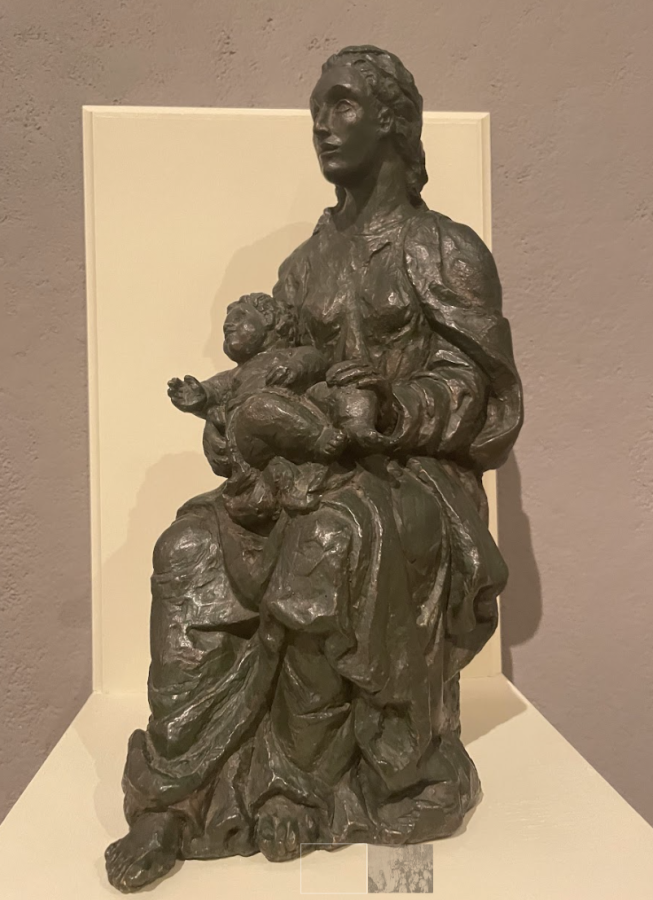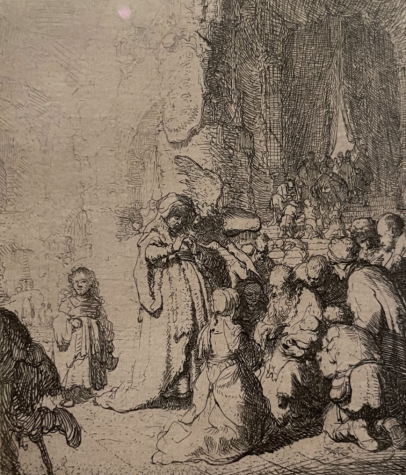Chapel Art exhibit Dilecta II explores origins, flourishes
Dialecta II features a Madonna and child sculpture by Sylvia Nicolas, creator of the Saint Anselm statue outside Alumni Hall.
December 7, 2022
The Chapel Art Center is a place many students have never ventured to in their time on the Hilltop, but is one of the most stunning places on-campus. Their latest exhibit, Dialecta II: Origins and Furnishes, signifies just how important the gallery is for the Saint Anselm College community and beyond with an extensive collection of artwork original to the college and containing works from famous artists like Rembrandt and feminist figure Marian Harris.
When I first walked into this exhibit, the first thought that came to mind was the remarkable scale and scope of the collection. Dialecta covers a large time period dating from religious medieval artwork of the fifteenth century to contemporary art from the twenty-first century. Dialecta also covers a variety of cultures ranging from American artists like Ernest Lawson and Mabel May Woodward to European and Asian painters and sculptors such as Sylvia Nicolas and William Hart. Here are a few of the highlights from Dialecta.
The first part of the exhibit shows works from the origins of the exhibit. The most striking feature of this part is a very large portrait of Abbot Hilary Pfraengle sitting perched on a wall welcoming visitors into the Chapel Art Center. Abbot Hilary was the second abbot of Saint Mary’s Abbey in Newark, New Jersey, who sent monks to Manchester to found what would be later called Saint Anselm Abbey. The portrait, painted by Fr. Raphael Pfisterer of Saint Anselm Abbey, shows Abbot Hilary sitting in a chair next to a window overlooking Alumni Hall. The portrait is very detailed and precise. The painted version of Alumni Hall is exactly the same as it would have looked at the time and what it looks like now. Abbot Hilary sits on a red chair, staring off in the distance holding a book that could have been the Liturgy of the Hours or the Bible. Abbot Hilary looks incredibly realistic, and if you look close enough, you can see the light shining in his eyes and the detail of his vestments.
As I continued walking through, I reached the second section of Dialecta. Furnishes mainly focused on theologically significant prints, paintings, and statues. One of the greatest pieces of the Dialecta exhibit is found in this second section: a small yet captivating etching of the presentation of Jesus in the Temple by artist Rembrandt Harmenszoon van Rijn. Rembrandt is a seventeenth century Dutch artist whose paintings would come to inspire painters like Vincent van Gogh and Edouard Manet. To understand the scale of Rembrandt’s artwork, a 2009 article from Reuters states that an unseen painting by Rembrandt sold for $33.2 million at a London auction. The etching itself is fascinatingly detailed for its small proportionate size. Mary appears kneeling at the feet of Simeon as onlookers observe the baby Jesus. In the background, Rembrandt etched a few kids kneeling in the temple right near the curtain of the Temple where it was believed that God dwelt and an angel coming down to point the widow Anna to Christ.
Also in this section are a few statues created by Sylvia Nicolas. Sylvia is best known for her many works around campus. Her father created the stained glass windows of the Abbey Church. Her mother created the statues in the entrance of the church. Sylvia herself made the mosaics in the sanctuary of the Abbey Church, the stained glass windows in the refectory of the monastery, the St. Benedict statue outside the monastery, the statue of Mary in the grotto, and most prominently, the statue of Saint Anselm right in front of Alumni Hall. In Dialecta, two more statues are displayed, one depicting Mary with the child Jesus and the other St. Joan of Arc. The statues are very similar to the statues of St. Benedict and St. Anselm on the college campus with a gray metallic look to them. However, they are still very detailed for their size and serve as a symbol of Sylvia’s contributions to the Saint Anselm community.
The last section of the exhibit is centered around furnishes from outside the college community. Here, landscapes and pottery cover the walls from more contemporary artists. One of the most captivating ones is a landscape by William Hart, a Dutch artist whose artwork dates back to 1857. The landscape is an oil on canvas surrounded by a beautiful golden frame with Hart’s name on the bottom. The oil painting depicts a fall day on the Esopus River in New York. Trees beginning to show their foliage drape themselves over a crystal clear water with mountains gazing down in the distance. Hart does a remarkable job showing intense detail from the scene: from the tiniest flowers to the reflection of the trees over the water and the smallest leaves on each tree.
Dialecta II has a significant amount to offer any college student interested in seeing beauty and seeing what the Chapel Art Center has in the permanent collection. Dialecta II will remain open to the college community until February 10.

Dialecta II includes a piece representing Jesus in the temple (left) as well as a portrait of Abbot Hilary Pfraengle (right). Courtesy / Tom Canuel




